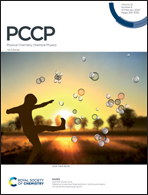Computer simulation study of fluorocarbon phosphate surfactant based aqueous reverse micelle in supercritical CO2: roles of surfactant functional groups, ionic strength, and phase changes in CO2
Abstract
Structural and dynamic properties of an aqueous micelle organized from fluorocarbon phosphate surfactant molecules in supercritical carbon dioxide (CO2) are investigated via molecular dynamics computer simulations. The roles of the functional groups and ionic strength of the surfactants on the formation of reverse micelles in supercritical CO2, and related water dynamics characterized as translational and reorientational dynamics, are systematically demonstrated by employing three different phosphate-based surfactants paired with sodium cations. The strong electrostatic interactions between the phosphate head groups and sodium cations result in formation of an aqueous core inside the surfactant aggregates, where water molecules are bonded together with loss of the tetrahedral hydrogen bonded network found in bulk water. It is found that all the three surfactants with CO2-philic fluorocarbon double tails build up well-stabilized reverse micelles in supercritical CO2, avoiding direct contacts between CO2 and water molecules. Despite this, the surfactant with a carboxylic ester linkage between the phosphate head and fluorocarbon tail group tends to coordinate water molecules toward sustaining the inter-water hydrogen bonds, indicating better efficiency at covering the aqueous core with hydrophobic groups compared to one without a carboxylic ester group. As for water molecules confined in the reverse micelle, their translational and reorientational motions, and fluctuating dynamics of the inter-water hydrogen bonds, significantly slow down compared to bulk water at ambient temperature. The water dynamics become more restricted with an increase in ionic strength of the anionic surfactant; this is attributed to divalent surfactant heads and sodium cations being more tightly bound together with bonding to water compared to monovalent ones. Lastly, the structural and dynamic changes of the reverse micelle caused by a phase change in CO2 are monitored with gradually decreasing temperature and pressure from the supercritical to gaseous state for CO2. The average reverse micelle structure equilibrated in supercritical CO2 is found to remain stable over a time period of 0.2 ms through a depressurization process to gaseous CO2. We note that the diverse pathways of surfactant self-aggregation in gaseous CO2 could be controlled by the preceding solvation procedure in the supercritical regime which governs the final aggregated structures in gaseous CO2.



 Please wait while we load your content...
Please wait while we load your content...